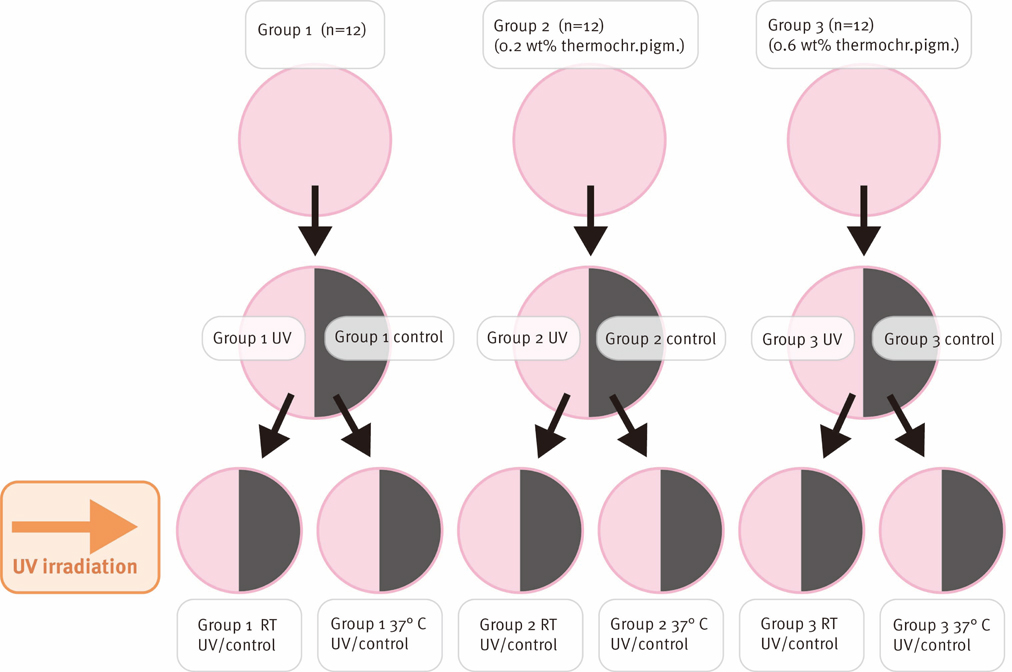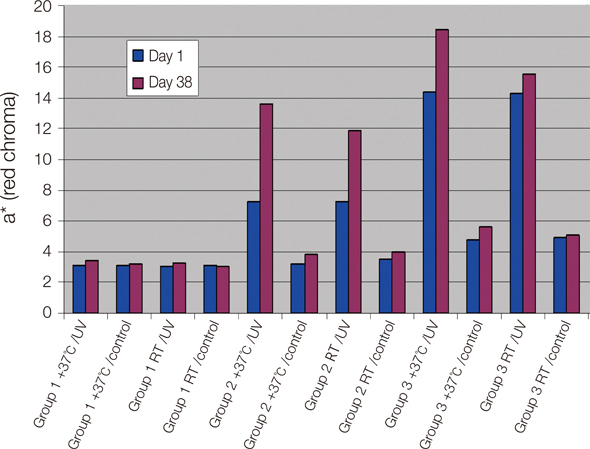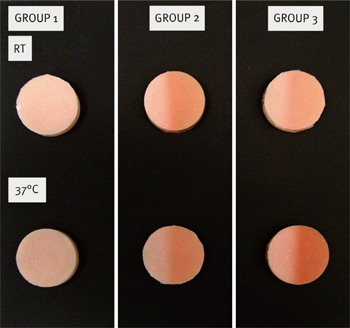J Adv Prosthodont.
2013 May;5(2):75-83. 10.4047/jap.2013.5.2.75.
Color stability of thermochromic pigment in maxillofacial silicone
- Affiliations
-
- 1Vaasa Central Hospital, Vaasa, Finland. rosita.kantola@vshp.fi
- 2University of Turku, Institute of Dentistry, Department of Biomaterials Science and Turku Biomaterials Centre - TCBC, Turku, Finland.
- 3University of Turku, Insttute of Dentistry, Department of Community Dentistry, Turku, Finland.
- KMID: 2284744
- DOI: http://doi.org/10.4047/jap.2013.5.2.75
Abstract
- PURPOSE
Maxillofacial silicone elastomer is usually colored intrinsically with color pigments to match skin colors. The purpose of this study was to investigate the color stability of a maxillofacial silicone elastomer, colored with a thermochromic, color changing pigment.
MATERIALS AND METHODS
Disc-shaped maxillofacial silicone specimens were prepared and divided into 3 groups: a conventionally colored control group, one group additionally colored with 0.2 wt% thermochromic pigment , and one group with 0.6 wt% thermochromic pigment. Half of the surface of each specimen was covered with an aluminium foil. All of the specimens were exposed to UV radiation in 6 hour cycles over 46 days. In between the UV exposures, half of the specimens were stored in darkness, at room temperature, and the other half was stored in an incubator, at a humidity of 97% and a temperature of +37degrees C. Color measurements were made with a spectrophotometer and registered according to the CIELAB L*a*b* color model system. The changes in L*, a* and b* values during artificial aging were statistically analyzed by using paired samples t-test and repeated measures ANOVA. P-values <.05 were considered as statistically significant.
RESULTS
The UV exposure resulted in visually noticeable and statistically significant color changes in the L*, a* and b* values in both of the test groups containing thermochromic pigment. Storage in the incubator lead to statistically significant color changes in the a* and b* values of the specimens containing thermochromic pigment, compared to those stored at room temperature.
CONCLUSION
The specimens containing thermochromic pigment were very sensitive to UV radiation, and the thermochromic pigment is not suitable, as such, to be used in maxillofacial prostheses.
MeSH Terms
Figure
Reference
-
1. Watson RM, Coward TJ, Forman GH. Results of treatment of 20 patients with implant-retained auricular prostheses. Int J Oral Maxillofac Implants. 1995; 10:445–449.2. Huber H, Studer SP. Materials and techniques in maxillofacial prosthodontic rehabilitation. Oral Maxillofac Surg Clin North Am. 2002; 14:73–93.3. Leonardi A, Buonaccorsi S, Pellacchia V, Moricca LM, Indrizzi E, Fini G. Maxillofacial prosthetic rehabilitation using extraoral implants. J Craniofac Surg. 2008; 19:398–405.4. Craig RG, Koran A, Yu R. Elastomers for maxillofacial applications. Biomaterials. 1980; 1:112–117.5. Ryan JE. Twenty-five years of clinical application of a heat-cured silicone rubber. J Prosthet Dent. 1991; 65:658–661.6. Gary JJ, Smith CT. Pigments and their application in maxillofacial elastomers: a literature review. J Prosthet Dent. 1998; 80:204–208.7. Seelaus R, Troppmann RJ. Facial Prosthesis Fabrication: Coloration Techniques. In : Taylor TD, editor. Clinical Maxillofacial Prosthetics. Carol Stream: Quintessence Publishing Co.;2000. p. 245–264.8. Leow ME, Ow RK, Lee MH, Huak CY, Pho RW. Assessment of colour differences in silicone hand and digit prostheses: perceptible and acceptable thresholds for fair and dark skin shades. Prosthet Orthot Int. 2006; 30:5–16.9. Haug SP, Andres CJ, Moore BK. Color stability and colorant effect on maxillofacial elastomers. Part III: weathering effect on color. J Prosthet Dent. 1999; 81:431–438.10. Craig RG, Koran A, Yu R, Spencer J. Color stability of elastomers for maxillofacial appliances. J Dent Res. 1978; 57:866–871.11. Koran A, Yu R, Powers JM, Craig RG. Color stability of a pigmented elastomer for maxillofacial appliances. J Dent Res. 1979; 58:1450–1454.12. Mohite UH, Sandrik JL, Land MF, Byrne G. Environmental factors affecting mechanical properties of facial prosthetic elastomers. Int J Prosthodont. 1994; 7:479–486.13. Lemon JC, Chambers MS, Jacobsen ML, Powers JM. Color stability of facial prostheses. J Prosthet Dent. 1995; 74:613–618.14. Beatty MW, Mahanna GK, Jia W. Ultraviolet radiation-induced color shifts occurring in oil-pigmented maxillofacial elastomers. J Prosthet Dent. 1999; 82:441–446.15. Haug SP, Moore BK, Andres CJ. Color stability and colorant effect on maxillofacial elastomers. Part II: weathering effect on physical properties. J Prosthet Dent. 1999; 81:423–430.16. Hulterström AK, Ruyter IE. Changes in appearance of silicone elastomers for maxillofacial prostheses as a result of aging. Int J Prosthodont. 1999; 12:498–504.17. Polyzois GL. Color stability of facial silicone prosthetic polymers after outdoor weathering. J Prosthet Dent. 1999; 82:447–450.18. Kiat-Amnuay S, Lemon JC, Powers JM. Effect of opacifiers on color stability of pigmented maxillofacial silicone A-2186 subjected to artificial aging. J Prosthodont. 2002; 11:109–116.19. Kiat-Amnuay S, Mekayarajjananonth T, Powers JM, Chambers MS, Lemon JC. Interactions of pigments and opacifiers on color stability of MDX4-4210/type A maxillofacial elastomers subjected to artificial aging. J Prosthet Dent. 2006; 95:249–257.20. Visser A, Raghoebar GM, van Oort RP, Vissink A. Fate of implant-retained craniofacial prostheses: life span and aftercare. Int J Oral Maxillofac Implants. 2008; 23:89–98.21. Hatamleh MM, Watts DC. Effect of extraoral aging conditions on color stability of maxillofacial silicone elastomer. J Prosthodont. 2010; 19:536–543.22. Veres EM, Wolfaardt JF, Becker PJ. An evaluation of the surface characteristics of a facial prosthetic elastomer. Part II: The surface texture. J Prosthet Dent. 1990; 63:325–331.23. Dootz ER, Koran A 3rd, Craig RG. Physical properties of three maxillofacial materials as a function of accelerated aging. J Prosthet Dent. 1994; 71:379–383.24. Polyzois GL, Tarantili PA, Frangou MJ, Andreopoulos AG. Physical properties of a silicone prosthetic elastomer stored in simulated skin secretions. J Prosthet Dent. 2000; 83:572–577.25. Eleni PN, Krokida MK, Polyzois GL. The effect of artificial accelerated weathering on the mechanical properties of maxillofacial polymers PDMS and CPE. Biomed Mater. 2009; 4:035001.26. Eleni PN, Katsavou I, Krokida MK, Polyzois GL, Gettleman L. Mechanical behavior of facial prosthetic elastomers after outdoor weathering. Dent Mater. 2009; 25:1493–1502.27. Haug SP, Andres CJ, Munoz CA, Bernal G. Effects of environmental factors on maxillofacial elastomers: Part IV--Optical properties. J Prosthet Dent. 1992; 68:820–823.28. Rosa DS, Angelini JMG, Agnelli JAM, Mei LHI. The use of optical microscopy to follow thedegradation of isotactic polyprophylene (iPP) subjected to natural and artificial aging. Polym Test. 2005; 24:1022–1026.29. Davis A, Sims D. Weathering of polymers. London: Applied Science Publishers;1983. p. 1–41.30. Kantola R, Kurunmäki H, Vallittu PK, Lassila LVJ. Use of thermochromic pigment in maxillofacial silicone elastomer. J Prosthod Dent. 2013; In press.31. Ogrodnik W. Use of color-changing pigment to detect wire and cable hazards. Wire J Int. 2008; 41:170–175.32. Hallcrest Inc. Handbook of thermochromic liquid crystal technology. Glenview: Hallcrest;1991.33. Lakio S, Heinämäki J, Yliruusi J. Colorful drying. AAPS PharmSciTech. 2010; 11:46–53.34. Commission Internationale de l'Éclairage (CIE) Colorimetry - technical report. CIE Pub. No. 15. 3rd ed. Vienna: Bureau Central de la CIE;2004.35. Gijsman P, Hennekens J, Janssen K. Comparison of UV degradation chemistry in accelerated (xenon) aging tests and outdoor tests (II). Polym Degrad Stab. 1994; 46:63–74.36. Sampers J. Importance of weathering factors other than UV radiation and temperature in outdoor exposure. Polym Degrad Stab. 2002; 76:455–465.37. Beatty MW, Mahanna GK, Dick K, Jia W. Color changes in dry-pigmented maxillofacial elastomer resulting from ultraviolet light exposure. J Prosthet Dent. 1995; 74:493–498.38. Kiat-amnuay S, Johnston DA, Powers JM, Jacob RF. Color stability of dry earth pigmented maxillofacial silicone A-2186 subjected to microwave energy exposure. J Prosthodont. 2005; 14:91–96.39. Han Y, Zhao Y, Xie C, Powers JM, Kiat-amnuay S. Color stability of pigmented maxillofacial silicone elastomer: effects of nano-oxides as opacifiers. J Dent. 2010; 38:Suppl 2. e100–e105.40. Kiat-amnuay S, Beerbower M, Powers JM, Paravina RD. Influence of pigments and opacifiers on color stability of silicone maxillofacial elastomer. J Dent. 2009; 37:Suppl 1. e45–e50.41. Li R, Yabe S, Yamashita M, Momose S, Yoshida S, Yin S, Sato T. UV-shielding properties of zinc oxide-doped ceria fine powders derived via soft solution chemical routes. Mater Chem Phys. 2002; 75:39–44.42. Löetzsch D, Seeboth A. Thermochromic Phenomena in Polymers. 1st ed. Shawbury, UK: Smithers Rapra Press;2008. p. 17–47.43. Caine MA, McCabe RW, Wang L, Brown RG, Hepworth JD. The inhibition of triphenylmethane primary dye fading in carbonless copying paper systems by singlet oxygen quenching bis(dithiocarbamato)nickel(II) complexes. Dyes Pigm. 2002; 52:55–65.44. Oda H. Photostabilization of organic thermochromic pigments. Part 2: Effect of hydroxyarylbenzotriazoles containing an amphoteric counter-ion moiety on the light fastness of color formers. Dyes Pigm. 2008; 76:400–405.45. ASTM D2244-11. Standard practice for calculation of color tolerances and color differences from instrumentally measured color coordinates. Pennsylvania, USA: ASTM International;2011. p. 1–12.
- Full Text Links
- Actions
-
Cited
- CITED
-
- Close
- Share
- Similar articles
-
- A STUDY ON THE EFFECT OF UV LIGHT ABSORBER ON THE COLOR CHANGE OF MAXILLOFACIAL SILICONE
- A STUDY ON THE PHYSICAL PROPERTIES AND COLOR STABILITY OF MAXILLOFACIAL PROSTHETIC SILICONE MATERIAL
- Color Stability of Self-Cured Temporary Crown Resin according to Different Surface Treatments
- Morphologic and Immunohistochemical Studies of Attached Retina in Intravitreal Silicone Oil
- Comparative evaluation of the subtractive and additive manufacturing on the color stability of fixed provisional prosthesis materials





